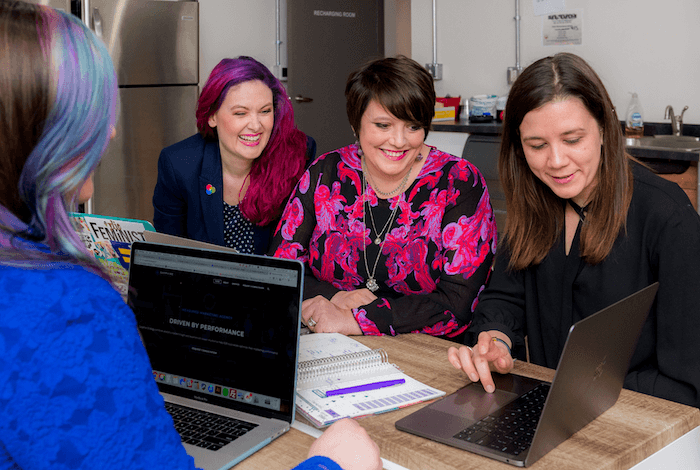By Nick Butler
Tags: Agile , Development

How do you ensure that the digital service you’re developing delivers just what your users need? One way is to actively involve your users in the design. Learn about the benefits of co-design for digital services and how to put it into action.
Co-design is a way of designing products or services with the active involvement of the users and stakeholders, to make sure the product or service meets the users’ needs.
Also called “participatory design”, it’s design with people not for people. It’s a form of user-centred design, but one in which users and stakeholders aren’t just consulted, they’re active participants. “Nothing about us without us” is the co-design mantra.
These products and services could be physical products, face-to-face or digital services, or things like strategies, policies and processes. In this post we’re focusing on co-design for digital services: web applications or mobile apps that help users complete a task or tasks.
The stakeholders will be the people who deliver and support the service. So that might include the developers and designers, the team that delivers any face-to-face version of the service, call centre or help desk staff, trainers, and the managers responsible for the service.
We’ve put together a case study showing what co-design looks like in practice. Find out how a collaborative government project proved that co-design is possible even under time pressure and in the middle of a pandemic lockdown.
Co-design case study: digital heritage inspires the Pacific
There are two main benefits of co-design for digital service development.
These principles help create a productive co-design relationship between the digital service experts and the users and stakeholders.
Agile pushes you in the direction of co-design. Working software is the main measure of progress in Agile because this allows you to test it with users. Extreme Programming, for example, involves the users by making the product leader an end-user, the XP customer. And Scrum is designed to provide regular chances to get the input of users and stakeholders, by delivering a releasable increment every sprint.
Our move into co-design has come out of our desire to get the most from this user involvement. We’ve especially put time into finding ways to get users actively involved early in a project. That’s because this lets us leverage the benefits throughout the project.
This is the process we tend to follow for co-design projects:
We’ve found that co-design discovery workshops are an effective way to involve the users and stakeholders early. Over the years, we’ve tested a bunch of activities that facilitate co-design in a fun and interactive way. These workshops let you:
Learn more about our approach to running discovery workshops.
There’s a lot of pressure on the facilitators in these workshops. If you keep coming back to the principles of co-design, you’ll stay on track.
You have to make sure the users and stakeholders know they are welcome and valued. Unlike the rest of the attendees, they are not experts in designing digital services, and this can be off-putting for them. They are, however, experts in the needs of people using the service.
You need to be able read the room so you can:
You’ll often be working with quite large groups. This means you’ll need to keep tight control of timeboxes. Regularly breaking into smaller groups helps with this by allowing discussions to take place in parallel.
Co-design is not a one-off. It’s not over and done with once you’ve completed your discovery workshop. You need to keep your co-design group involved as you iteratively develop your digital service.
Keeping them involved means both getting their input, and showing how their input has fed into the evolving digital service. This transparency is a powerful way to maintain engagement.
There are three key ways to get their input into how well what you’ve built meets their needs. These are:
At the end of each iteration, the co-design group undertakes a review of the latest work with the development team. You base this review around a demo of the working features. As a result, the co-design group can see the digital service in action. This allows for hands-on interaction and meaningful feedback.
This feedback then drives the priorities for the work ahead. Because of this, the co-design group has real input into the shape of the service.
Just asking users what they want isn’t enough. That’s because research shows that what users say they want from a digital service is not always what they need. Our ideas about the way we use things are often wrong.
Think, for example, of the car Homer Simpson designed. It gave him everything he wanted, but little he needed (and bankrupted his brother’s company into the bargain).

The best way to find out how well your service meets their needs is through user testing. Watching real users completing real tasks gives you hard data to guide future work.
Steve Krug’s Rocket Surgery Made Easy sets out the art and science of user testing.
For shorter projects, consider having facilitated catch-ups with your co-design group more than once an iteration. That’s because this lets you get fast feedback on the latest features you’re working on. But keep them quick and focused.
Co-design is often driven by a desire to help the disadvantaged, to give a voice to the marginalised. This may explain why it’s gaining traction in the health and social sectors.
Interestingly, Google Trends shows that most interest in co-design comes from New Zealand. Perhaps this reflects the inclusive and egalitarian nature of kiwis and kiwi society.
Co-design Workshop Resource — Penny Hagen
An introduction to Co-Design principles and practice PDF— Auckland Co-design Lab
Co-Design Workshop Resources — The Change Foundation
Co-design resources for cultural heritage professionals — meSch